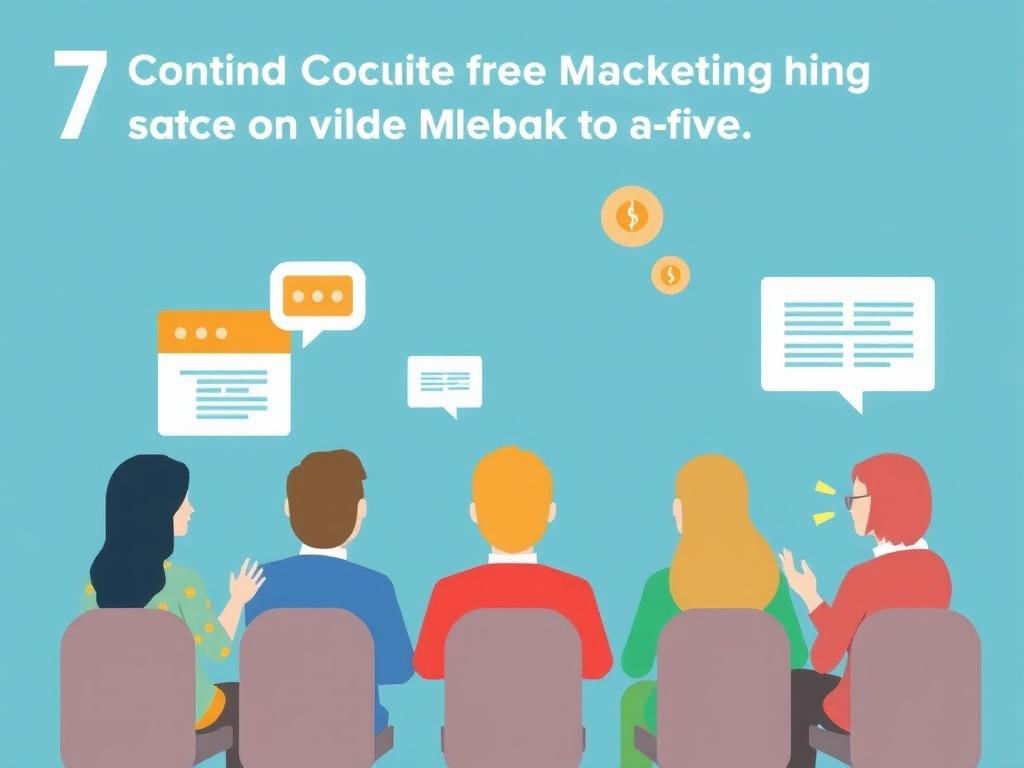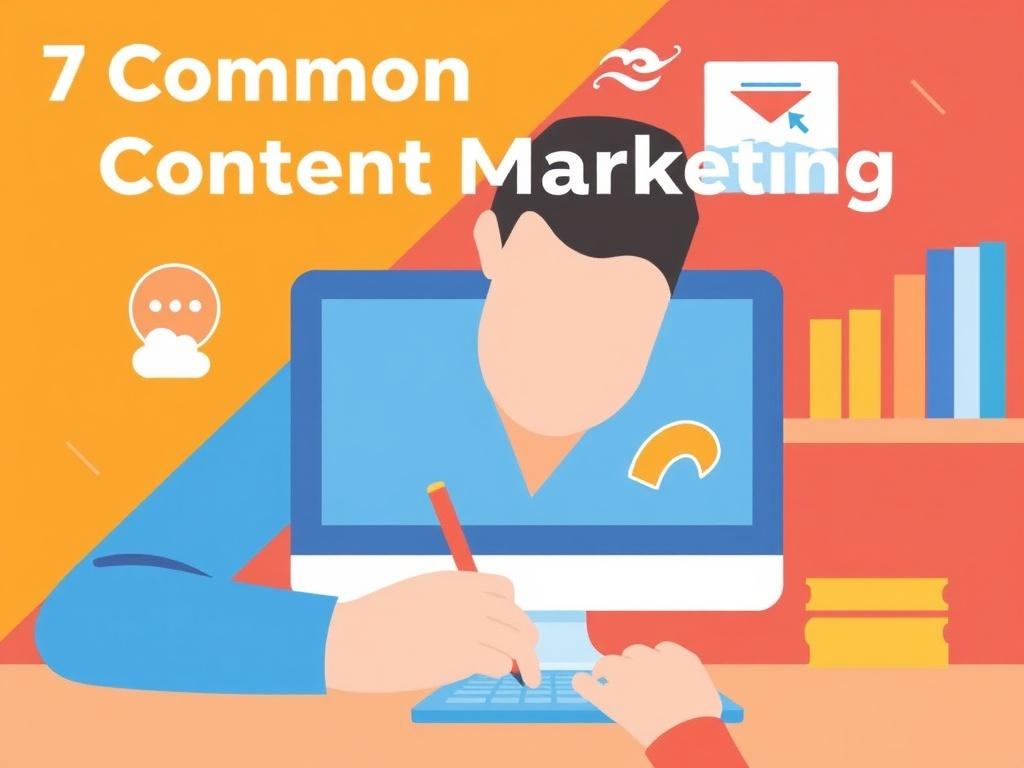Content marketing is one of those ideas that sounds simple on the surface: create great content, share it, and watch the audience grow. But any marketer who’s been at this for a while knows the truth is messier. The reality is full of small errors that add up — inconsistent publishing schedules, vague goals, content that talks at people instead of helping them. Those mistakes don’t just waste time; they quietly erode trust and momentum. In this article I’ll walk you through seven common content marketing mistakes, explain why they’re so damaging, and give practical, realistic ways to avoid them. No jargon-heavy theory — just honest, tactical advice you can start using this week.
If you’re managing a blog, a social account, or a full content funnel, this piece will serve as a steady companion. I’ll share concrete examples, quick-check lists, and a compact table to compare mistakes with fixes. Whether you’re solo or part of a team, the goal here is to leave you with a clearer sense of what to stop doing and what to do instead. Let’s get into it.
Mistake 1: Not Knowing Your Audience Well Enough

One of the most painful mistakes is producing content without a clear picture of who you’re talking to. It’s easy to fall into the trap of making content that seems impressive to you but is irrelevant to your customers. Maybe you produce highly technical whitepapers when your audience craves quick, visual explainers. Or perhaps you create long-form blog posts that your audience only skims on mobile. Without audience clarity, your content will underperform no matter how polished it looks.
Knowing your audience involves more than demographic guesses. You want to understand what keeps them awake at two in the morning, what terms they use to describe their problems, where they look for answers, and how they prefer to consume information. Start by creating or updating buyer personas and pairing them with real data: website analytics, search queries, social listening, customer support transcripts, and direct interviews. If you can’t speak to customers directly, analyze your top-performing content to see who engages and why.
Practical steps:
- Conduct three 20-minute interviews each month with real customers or prospects.
- Map user intent: categorize top questions your content should answer into awareness, consideration, and decision stages.
- Use analytics to identify the pages that drive conversions and replicate their structure and tone.
Why this mistake lingers
Teams often default to assumptions because it’s faster or because no one is assigned to research. Fixing this takes time and curiosity — not heroics. Start small, commit to listening, and you’ll find your content becomes both easier to create and more effective.
Mistake 2: Producing Content Without Clear Goals
Too often, content teams measure activity instead of outcomes. Views, likes, and shares feel good, but they aren’t always aligned with business goals. Without clear objectives for each piece of content, you can’t tell whether it helped move people down the funnel or just made noise. The result? Content that looks busy but doesn’t contribute to leads, sales, retention, or brand equity.
Every piece should have a purpose. Is it to build awareness, capture leads, educate customers, or reduce churn? Define that goal up front and pick a single primary KPI: traffic, click-through rate, lead conversions, demo requests, or churn reduction. Secondary metrics are fine, but the primary KPI is what you’ll optimize for.
Action plan:
- Before you write anything, write a one-sentence goal and the primary KPI for the content.
- Use a content brief template that requires goals, target persona, distribution plan, and success metrics.
- Review content performance monthly and iterate: double down on what moves your KPI, pause what doesn’t.
How to set useful goals
Start by aligning content goals with your business funnel. For example, top-of-funnel content should focus on reach and awareness; middle-of-funnel on engagement and email signups; bottom-of-funnel on conversions. Clarity here prevents the common mismatch of treating a social post like it should drive demo requests when it’s really meant to introduce the brand.
Mistake 3: Ignoring Content Distribution and Promotion
You can spend hours crafting the perfect guide or video, but if nobody sees it, it won’t help your business. Many teams focus almost exclusively on content creation and assume distribution will follow naturally. It won’t. Great distribution multiplies content’s impact. The best content strategy includes a distribution plan before you hit publish.
Think of promotion like planting seeds in multiple gardens. Organic search is vital for evergreen pieces, social can spark quick attention, email nurtures your captive audience, and paid amplification gets content in front of people who don’t yet know you. Each channel needs different formats and messaging. Repurpose: turn a long guide into a sequence of short posts, design shareable visuals, and create email-exclusive snippets to drive clicks.
Distribution checklist:
- Define primary and secondary channels for each content piece.
- Create at least three derivative formats: social posts, email blurb, and one short video or graphic.
- Allocate a modest budget for paid promotion for content supporting conversion goals.
Common distribution mistakes
A frequent error is relying solely on organic social without building an email list. Social algorithms change; email offers consistent reach. Another misstep is generic promotion — don’t post the same caption across platforms. Tailor the message to each audience and format.
Mistake 4: Chasing Quantity Over Quality
When pressure mounts, it’s tempting to churn out high volumes of content in the belief that more means better results. But low-quality, repetitive content quickly turns readers off and damages brand credibility. The algorithm may reward regular activity, but readers reward value. One genuinely useful long-form guide can outperform a dozen mediocre posts.
Quality doesn’t always mean longer. It means clarity, originality, and usefulness. A well-researched 800-word post that answers a real question and provides actionable steps is worth more than a 2,000-word vanity post that rehashes what’s already out there. Focus on content that serves specific needs and demonstrates your expertise.
How to shift from quantity to quality:
- Establish content standards and a review checklist (accuracy, sources, novelty, readability).
- Audit existing content quarterly and remove or update underperforming pieces.
- Invest a bit more time in headlines and introductions — these drive clicks and lower bounce rates.
When quantity is still useful
There are cases where regular publishing helps — e.g., timely news updates, daily social posts for community engagement, or syndicated content in a high-frequency channel. The key is to keep standards proportional to the channel’s purpose and to ensure even frequent content has a clear value proposition.
Mistake 5: Failing to Optimize for SEO and User Intent
Publishing content without considering search intent is like opening a shop without a sign. SEO isn’t about gaming the system with keywords; it’s about matching content to what people actually search for. When you ignore keyword research and user intent, you miss opportunities to attract the right audience and waste content that could be a reliable acquisition engine.
Start with intent mapping. For each topic, determine whether the searcher is researching broadly, comparing options, or ready to purchase. Then craft content that meets that intent. Use keyword tools to identify realistic opportunities — long-tail queries often offer better ROI than ultra-competitive short phrases. And optimize technical aspects: meta titles, headings, image alt text, and internal linking.
SEO practicalities:
- Perform a basic keyword-intent map for your top 20 target topics.
- Use a content template that includes recommended HTML heading structure and meta fields.
- Audit site performance: mobile-friendliness and page speed directly affect rankings and user satisfaction.
Don’t forget user experience
SEO and UX go hand in hand. Good content that’s hard to read or slow to load will frustrate users and hurt search performance. Prioritize readable structure, scannable sections, and clear next steps so users can act after consuming content.
Mistake 6: Not Measuring the Right Metrics

Metrics are seductive. Dashboards full of colorful charts can make you feel productive while masking real problems. Measuring only vanity metrics — pageviews, followers, or raw social engagement — gives an incomplete picture. What matters are metrics that reflect progress toward your content goals: leads, conversion rates, customer retention, time to purchase, or cost per acquisition.
The right metrics depend on the stage of the funnel and your specific goals. For example, if your aim is lead generation, look at the conversion rate for content-based CTAs, email list growth, and the quality of leads (lead-to-opportunity rate). If your goal is education and retention, measure changes in support ticket volume, product activation rates, and NPS for customers exposed to educational content.
A measurement framework:
- Define primary and secondary KPIs for each content type.
- Set a baseline and realistic targets with timelines (e.g., increase lead conversions from content by 20% in 6 months).
- Use attribution models to see how content contributes across the funnel; include assisted conversions, not just last-click.
How to avoid analysis paralysis
Pick a small set of metrics (3–5) that tell the story of performance for each content bucket. Track them consistently and review monthly. If you’re drowning in data, simplify by focusing on what impacts revenue and user outcomes most directly.
Mistake 7: Treating Content as a One-Off Rather Than an Ongoing Program
A single great article or viral post is wonderful, but sustainable content marketing treats content as part of a program with iteration, repurposing, and lifecycle management. Many teams publish once and move on, forgetting to update, repromote, or repurpose. Content decays — facts change, search intent evolves, and formats shift — so a programmatic approach keeps your assets working for you.
Think in terms of content lifecycles: ideation, creation, promotion, measurement, iteration, and archiving. Build a calendar that balances evergreen pillars with timely pieces. Revisit high-performing content to keep it fresh, and convert long-form content into webinars, email courses, and social snippets.
Practical lifecycle plan:
- Create a content calendar with themes for each quarter and specific repurposing actions for every major piece.
- Schedule quarterly audits to update facts, refresh CTAs, and improve SEO.
- Systematically repurpose top-performing pieces into three new formats within 60 days of publishing.
Systems beat heroics
Relying on one-off brilliance is risky. Systems — simple documented processes for ideation, review, and promotion — make content production repeatable and scalable. Start with a lightweight playbook and evolve it as you learn.
Practical Examples: Common Scenarios and How to Fix Them
Real-world examples can make these ideas click. Here are a few scenarios you might recognize, along with concrete fixes.
Scenario A: The Blog that Doesn’t Convert
You publish weekly essays that get decent traffic but almost no leads. The fix: audit post content and add mid-article, contextually relevant CTAs tailored to the topic’s intent. Replace generic newsletter CTAs with targeted offers — e.g., a downloadable checklist or a short email course — that match the article’s problem-solving angle.
Scenario B: The Social Account with Lots of Likes but No Business Impact
Your brand gets engagement but few website visits or signups. The fix: build a distribution plan that prioritizes traffic-driving posts and uses social to spark curiosity, then retarget engaged users with ads or email capture forms. Use platform-native formats (short video, carousel) to increase clicks, not just reactions.
Scenario C: Evergreen Content that Falls Behind
An old guide once ranked well but now appears stale. The fix: update the guide with current stats, new examples, and a refresh of on-page SEO (title tags, headings). Promote the updated content as an “updated guide” through email and social, and repurpose parts into new posts or short videos.
Toolbox: Tools and Templates to Make It Easier

You don’t need expensive software to begin correcting these mistakes. Start with a few simple tools and lightweight templates.
- Editorial brief template: title, persona, goal, KPI, distribution plan, and deadline.
- Content calendar: a shared sheet with status, owner, publish date, and repurposing steps.
- Simple analytics dashboard: traffic, conversion rates by content, and one engagement metric.
Here’s a compact table that matches common mistakes with quick fixes and an action timeline:
| Mistake | Quick Fix | Action Timeline |
|---|---|---|
| Not knowing your audience | Conduct short customer interviews and analyze top-performing content | 2–4 weeks |
| No clear goals | Set primary KPI per content piece and use briefs | Immediate |
| Poor distribution | Create a channel-specific promotion plan and repurpose content | 1–2 weeks per piece |
| Quantity over quality | Implement content standards and audit low performers | Monthly |
| Ignoring SEO/intent | Map intent and optimize on-page elements | 2–6 weeks |
| Wrong metrics | Choose 3–5 relevant KPIs and track consistently | Immediate |
| One-off thinking | Create a lifecycle plan and repurposing schedule | Quarterly |
Checklist: A Simple Framework to Audit Your Content Program
Run through this checklist as a monthly or quarterly health check for your content program. Each “yes” should feel easy to justify. Each “no” is an opportunity.
- Do most content pieces have a clear primary goal and KPI?
- Do you know which audience segment each piece targets?
- Is there a distribution plan before publishing?
- Is the content optimized for a clear user intent and relevant keywords?
- Are you tracking conversion-related metrics and business outcomes?
- Do you repurpose and update top-performing content regularly?
- Is there a simple editorial process with roles and timelines?
How to Make Changes Without Disrupting the Team
Change is easier when it’s incremental. You don’t have to rebuild everything overnight. Start with low-friction wins that show value quickly and build credibility for bigger changes.
Step-by-step rollout:
- Week 1–2: Introduce content briefs for new pieces and set KPI expectations.
- Week 3–6: Run interviews and update buyer personas. Add one distribution checklist to every major piece.
- Month 2–3: Audit existing content; refresh top 10% of pieces and remove or consolidate the bottom 20%.
- Month 3–6: Implement a repurposing schedule and integrate performance reviews into monthly meetings.
Use these early wins to show measurable impact — a small increase in leads, a faster email sign-up rate, or better search rankings — then expand your initiatives.
Common Objections and How to Answer Them
Teams often resist change with a few predictable objections. Here’s how to respond.
Objection: “We don’t have time for interviews and audits.”
Response: Start with five 15-minute interviews and a micro-audit of your top five pages. Small investments yield useful insights and reduce wasted effort.
Objection: “We need more content to stay visible.”
Response: Publish less but better, and repurpose content to maintain frequency without lowering quality. Quality retains attention; volume alone doesn’t.
Objection: “SEO is slow; we need immediate results.”
Response: Balance quick wins (paid promotion, email campaigns, targeted offers) with long-term SEO investments. Short-term and long-term strategies can coexist.
Examples of Brands Doing This Well
Looking at real brands helps make these principles tangible. Companies that succeed with content marketing treat it like a product: they iterate, measure, and prioritize user experience.
— A B2B SaaS company that publishes fewer but deeper guides and uses gated mini-courses for middle-of-funnel lead capture. They pair each guide with a repurposed webinar and targeted LinkedIn ads for promotion.
— A consumer brand that builds short, snackable video lessons from its long-form blog content, distributes them on TikTok and Instagram, and uses email to drive deeper engagement.
— A niche consultancy that treats every blog post as a sales enablement tool, tailoring CTAs by persona and linking content to a CRM-driven nurture sequence.
These firms show that when content is planned, measured, and repurposed, it becomes a reliable growth engine.
Final Tips: Small Habits That Produce Big Results
Big changes start with small habits. Here are a few to adopt today:
- Always start with a one-sentence goal for each content piece.
- Keep a living ideas backlog tied to real customer questions.
- Repurpose immediately: after publishing, create three short social posts and a newsletter blurb.
- Schedule a 30-minute monthly content review meeting focused on outcomes, not activity.
- Document one improvement to your process every month and share it with the team.
Conclusion
Content marketing is a long game, but it doesn’t have to be mysterious. Avoiding the seven mistakes here — not knowing your audience, lacking clear goals, ignoring distribution, prioritizing quantity over quality, overlooking SEO and intent, measuring the wrong metrics, and treating content as one-off — will save time, money, and frustration. The cure is practical: listen to your audience, set clear KPIs, plan promotion in advance, commit to quality, optimize for search intent and UX, measure outcomes that matter, and treat content as an ongoing program. Start small with a few measurable changes, and you’ll build momentum. Over time, those small shifts lead to content that not only attracts attention but drives real business results.